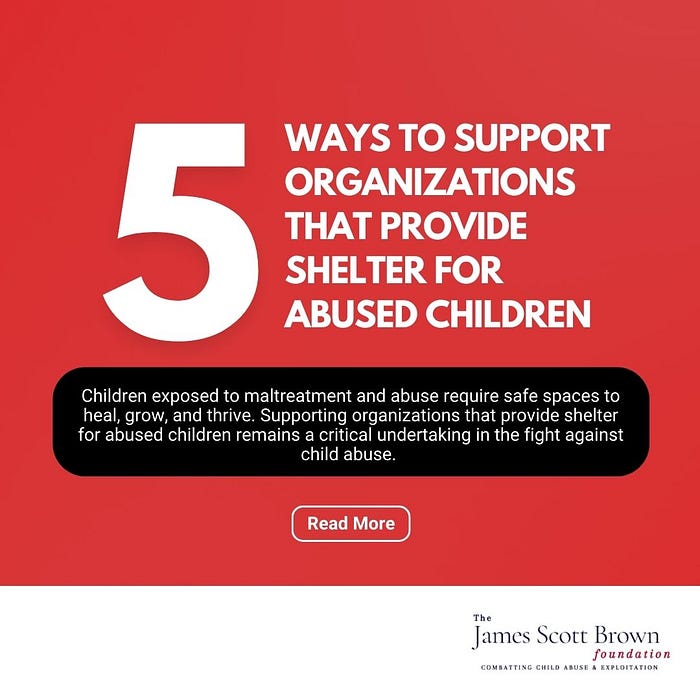5 Ways to Support Organizations That Provide Shelter for Abused Children by James Scott Brown Foundation
by James Scott Brown Foundation

Abstract:
Children exposed to maltreatment and abuse require safe spaces to heal, grow, and thrive. Supporting organizations that provide shelter for abused children remains a critical undertaking in the fight against child abuse. This article outlines five effective ways individuals can lend their support to these organizations, from financial contributions to volunteering time and skills. By comprehending and employing these methods, we can play a vital role in shaping brighter futures for vulnerable children.
Introduction:
Protecting abused children and providing a nurturing environment for them to recover is of paramount importance in combating the long-lasting impact of abuse. Organizations that offer shelter for these children play a crucial role in this process, yet they often face challenges in securing sufficient resources to sustain their work. By understanding how to effectively support these organizations, individuals can contribute significantly to the collective effort of safeguarding children and promoting their well-being.
1.Financial Contributions:
One of the most direct ways to support shelter-providing organizations is through monetary donations (Small, 2011). Funding enables these organizations to maintain their facilities, provide essential services such as counseling and education, and employ qualified staff. Regular contributions or one-time donations can make a lasting impact, ensuring that resources are available for the children in need.
2. Volunteering Time and Skills:
Contributing one’s time and skills is another powerful method to assist organizations working with abused children (Trickett, Noll, & Putnam, 2011). Whether through direct involvement with children, such as tutoring or mentoring, or by offering administrative and logistical support, volunteers can play a vital role in the organization’s daily operations.
3. Raising Awareness:
Spreading the word about the work of shelter-providing organizations within one’s community helps to increase awareness of child abuse and the necessity of intervention (Gilbert et al., 2009). Hosting or participating in events, sharing information through social media, and engaging with local media outlets can all contribute to this cause, thereby attracting further support and resources.
4. Advocacy and Policy Engagement:
Child protection requires a comprehensive approach that addresses the underlying issues and systemic challenges. By engaging in advocacy efforts and policy discussions, individuals can support organizations in their pursuit of legislative changes to safeguard abused children (Gilbert et al., 2009). This may involve contacting local representatives, participating in policy forums, or collaborating with other advocacy groups.
5. In-Kind Donations:
Organizations that provide shelter for abused children also require material resources to maintain their facilities and offer a comfortable environment for the children. Donating essential items such as clothing, bedding, or school supplies can make a tangible difference in the lives of these children (Small, 2011).
Conclusion:
Supporting organizations that provide shelter for abused children is a collective responsibility that requires the involvement of individuals from all walks of life. By embracing various methods of support, including financial contributions, volunteering, raising awareness, engaging in advocacy, and offering in-kind donations, we can help these organizations in their essential work, ultimately promoting the healing and growth of abused children.
References:
Gilbert, R., Widom, C. S., Browne, K., Fergusson, D., Webb, E., & Janson, S. (2009). Burden and consequences of child maltreatment in high-income countries. The Lancet, 373(9657), 68–81.
Small, M. A. (2011). Unanticipated gains: Origins of network inequality in everyday life. Oxford University Press.
Trickett, P. K., Noll, J. G., & Putnam, F. W. (2011). The impact of sexual abuse on female development: Lessons from a multigenerational, longitudinal research study.
Read more at the James Scott Brown Foundation.
Comments
Post a Comment